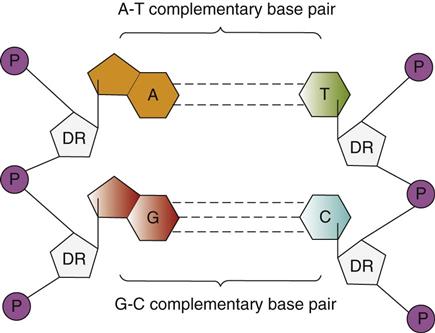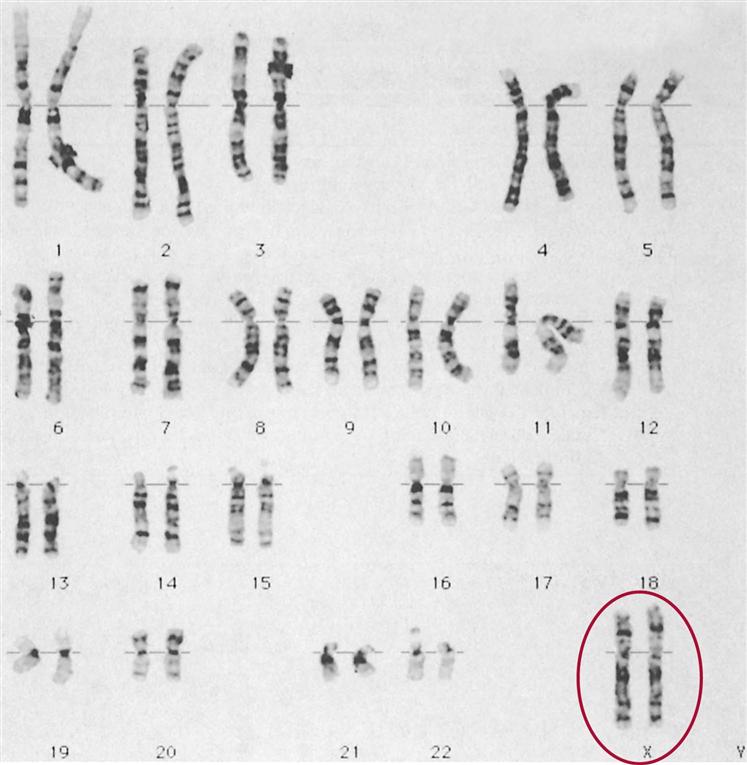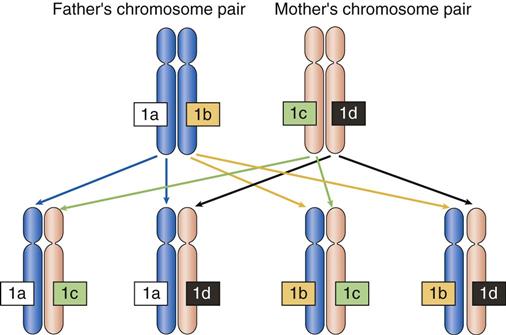M. Linda Workman
Genetic Concepts for Medical-Surgical Nursing
Learning Outcomes
Safe and Effective Care Environment
Health Promotion and Maintenance
Psychosocial Integrity
Physiological Integrity
7 Compare the concepts of phenotype and genotype.
8 Compare the patterns of inheritance for single gene traits.
9 Explain how genetic variations can affect adult health problems and their management.
11 Identify patients at increased genetic risk for health problems.
12 Explain how genetic testing is different from other laboratory tests.
13 Describe the role of the medical-surgical nurse in genetic counseling.

http://evolve.elsevier.com/Iggy/
Animation: Hereditary Traits
Answer Key for NCLEX Examination Challenges and Decision-Making Challenges
Audio Glossary
Key Points
Review Questions for the NCLEX® Examination
Genetics, genomics, and genomic health care are common terms in health care today. Genetics is concerned with the general mechanisms of heredity and the variation of inherited traits. The definition of genomics is both broader and more specific, focusing on the function of all of the human DNA, including genes and noncoding DNA regions. Genomic health care is the application of known genetic variation to enhance health care to individuals and their families.
How does genomic health care relate to medical-surgical nursing? Many adult-onset health problems have a genetic basis, meaning that genetic variation at the cellular level contributes to the person’s risk for disease development. Some of these health problems also demonstrate heritability, meaning that the risk for developing the disorder can be transmitted to one’s children in a recognizable pattern. Some adult-onset disorders, such as Huntington disease, are unavoidable when a person inherits a specific genetic mutation that causes the disorder. For other health problems, the risk is increased but is not absolute, indicating a predisposition or susceptibility toward the problem when a specific genetic mutation is inherited. Such a disorder may never occur, depending on what additional environmental factors interact with the increased genetic risk. For example, certain gene variations increase the risk for type 2 diabetes in some people; however, the disease is much more likely to develop only when the person with the genetic variation has a sedentary lifestyle and is overweight. Thus, although obesity is not good for anyone, it is clearly more dangerous for some people than others. One outcome of genomic health care is to identify personal risk for disease development and assist the person to reduce the risk by modifying his or her environment.
Although not everything is known about human genomics, specific discoveries regarding each person’s genetic differences are being used to assess disease risk, enhance disease prevention strategies, and personalize disease management approaches. As a result, all health care professionals, including registered nurses, are expected to have at least a minimum knowledge of basic genetics to provide the best possible care for patients and families. Professional organizations, such as the American Nurses Association, the American Association of Colleges of Nursing, the American Academy of Nursing, and the National League for Nursing, as well as many specialty nursing organizations, support this position. These groups have agreed with the competencies established by the National Coalition for Health Professional Education in Genetics (NCHPEG) as the minimum essential genetic competencies required for safe nursing practice and have defined additional selected competencies. Table 6-1 lists selected genetic competencies considered particularly important in medical-surgical nursing.
TABLE 6-1
SELECTED ESSENTIAL GENETIC COMPETENCIES FOR MEDICAL-SURGICAL NURSING PRACTICE

Adapted from competencies identified by American Association of Colleges of Nursing. (2008). The essentials of baccalaureate education for nursing practice. Washington, DC: Author; American Nurses Association. (2008). Essentials of genetic and genomic nursing: Competencies, curricula guidelines, and outcome indicators (2nd ed.). Silver Springs, MD: Author; National Coalition for Health Professional Education in Genetics. (2007). Core competencies in genetics for health professionals (3rd. ed.). Retrieved October 2010, from www.nchpeg.org/core/core_comps_english2007.pdf.
The purpose of this chapter is to build on what you have learned about basic genetics in your science classes and to apply this information to adult health care. Although nurses are not expected to be genetic experts, they need to know enough about basic genetics to recognize when a patient or family has a possible genetic risk for a health problem and to coordinate the attention of health care team members to ensure appropriate care.
Genetic Biology
Genes are the instructions for the making of all the different substances the human body produces. Think of all the hormones, enzymes, and other proteins the human body makes. It is the specific genes that tell each cell what protein to make, how to make it, when to make it, and how much to make. Think of each gene as a specific “recipe” for making a protein.
Most genes (more than 99%) are located in the nucleus of body cells. An important fact to remember is that every human cell with a nucleus contains the entire set of human genes. This complete set of genes is called the genome. (Mature red blood cells do not have a nucleus and thus contain no genes.) The human genome contains between 20,000 and 25,000 genes. For example, all cells have the gene for insulin. However, even though all cells have the gene for insulin, the only cell type that allows the insulin gene to be active and make insulin is the beta cell of the pancreas. So, although the insulin gene is present in skin cells, heart cells, brain cells, and other cells, only in the beta cells is this gene selectively “turned on” (expressed) when insulin is needed.
Genes are composed of DNA, which is present as 46 separate large chunks within the nucleus (Fig. 6-1). During cell division, each large chunk of DNA replicates and then organizes into a chromosome form to ensure precise delivery of the genetic information to each of the two new daughter cells. Thus DNA, chromosomes, and genes are all the same basic thing; only the structures differ.
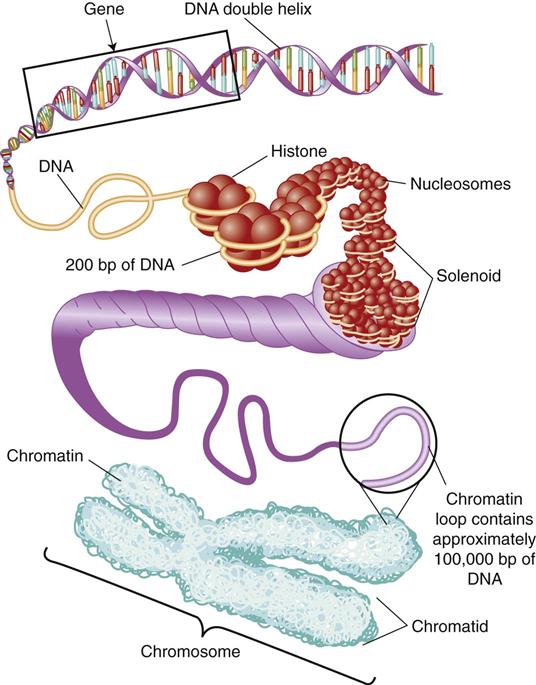
Each chromosome has many genes within it. Humans have 23 pairs of chromosomes—46 individual chromosomes. The Y chromosome, a small chromosome, has fewer than 100 genes. Larger chromosomes, such as the number 1 chromosome, contain thousands of genes.
One way to think of it is to consider all the DNA in any cell’s nucleus to be a giant “cookbook” containing all the recipes needed to make all the proteins, hormones, enzymes, and other substances your body needs. The chromosome pairs are the different book chapters (so the human genome cookbook has 23 chapters), and the genes are the individual recipes contained within the chapters.
There is a specific chromosome location (locus) for every gene. For example, the locus for the gene for blood type is on chromosome 9. The locus for the gene for part of hemoglobin is on chromosome 11. We now know the location and the exact DNA sequence for many, but not all, genes.
DNA
DNA Structure
In humans, DNA is a linear, double-stranded structure composed of multiple units of four different nitrogenous bases, each attached to a sugar molecule. The bases in each strand are linked together by phosphate groups. These two individual strands are held together loosely. This double-stranded DNA is arranged like a long set of railroad tracks. The “backbones” of the track are the two long steel rails. For DNA, these backbones are the phosphate groups that hold the bases in place. The bases are the individual railroad ties. Think of each tie as having two pieces—one piece attached to the right-hand rail and one piece attached to the left-hand rail.
Fig. 6-2 shows a very small piece of double-stranded DNA on the left (containing only four base pairs) taken from the larger piece of DNA on the right. The phosphate groups that hold the nucleotides together as a strand are in the red box. The green box in the lower left-hand section shows a whole nucleotide (a base with the sugar and the phosphate group) in place in the left-hand DNA strand. The blue box in the middle of the two strands shows how the base from the left strand lines up with and pairs to a complementary base in the right strand.
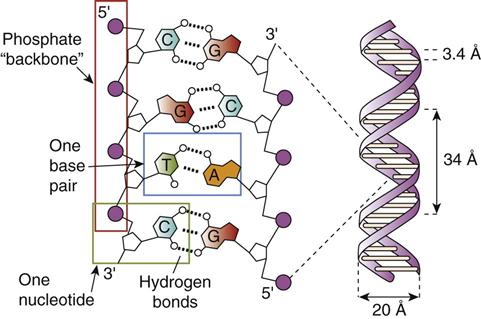
Bases are the essential parts of DNA. Many trillions of bases in the DNA are found in the nucleus of just one cell. In fact, if a cell could be cracked open like an egg and the nucleus (yolk) extracted and opened, the amount of DNA in the nucleus, stretched out, would be about 6 feet long. If the DNA in one cell could be made large enough to see and touch (about the width of a tape measure), it would be long enough to stretch out more than 1000 feet! There is much more DNA in each nucleus than is needed for the 25,000 genes. The gene DNA makes up only about 5% of all the DNA in each cell.
The four bases in DNA are adenine (A), guanine (G), cytosine (C), and thymine (T). Each base becomes a complete nucleotide when a five-sided sugar (known as a deoxyribose sugar) and a phosphate group are attached (Fig. 6-3). Nucleotides form the DNA strands with the phosphate groups holding the bases in place.
Base pairs are the linked bases in the two opposite strands of DNA. The bases always link together across from each other in a very specific way. Thymine always forms a pair with adenine, and cytosine always forms a pair with guanine. Thus the bases of each pair are complementary to each other. Because these complementary base pairs in DNA are specific, if the base sequence of one strand of DNA is known, the opposite strand’s sequence could be accurately predicted. For example, if the left-hand section of DNA (strand 1 in Fig. 6-4) had the sequence A-G-G-C-T-C-A-A-C-C-T-G, the corresponding (complementary) right-hand section (strand 2 in Fig. 6-4) of DNA would have the sequence T-C-C-G-A-G-T-T-G-G-A-C.
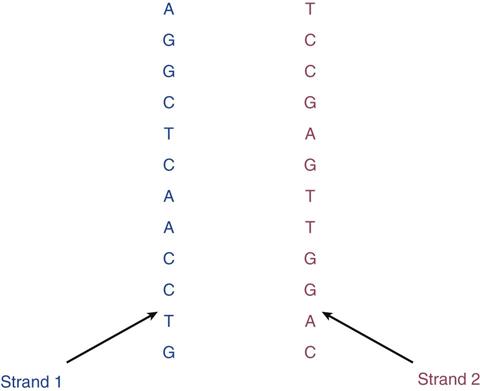
When the two strands of DNA are lined up properly, they twist into a loose helical shape (see Fig. 6-1). In this shape, the DNA is so fine that it can be seen only with electron microscopes. Only when a cell begins to divide (i.e., undergoes mitosis) does the DNA super-coil tightly into dense pieces called chromosomes (see Fig. 6-1), which can be seen with standard microscopes.
DNA Replication
DNA must reproduce itself (replicate) every time a cell divides. Cell division (mitosis) occurs in a regulated pattern known as the cell cycle. The purpose of mitosis is for one cell to reproduce into two new cells, each of which is identical to the cell that started mitosis. For each new cell to have exactly the right amount of DNA and genes, the DNA in the dividing cell must exactly replicate. This process involves having the double strands of DNA separate and then enzymes read the sequence of the original strands and build two new strands that are perfectly complementary to the original strands (Fig. 6-5).
When DNA synthesis is complete, the result is two sets of double-stranded DNA. Each of the two sets has one old strand and one new strand. At the time of actual cell division with the separation into two new cells, one set of DNA will move into one of the two new cells made during mitosis and the second set will move into the other new cell. In this way, every new cell ends up with exactly the right amount of DNA with all the genes.
Chromosomes
As shown in Fig. 6-1, a chromosome is a specific large chunk of highly condensed double-stranded DNA, with each chunk containing billions of bases and hundreds (and sometimes thousands) of genes. Each chromosome forms and moves to the center of the cell that is about to divide. Just before the cell splits into two cells, each chromosome is pulled apart so that half of each chromosome goes into one new cell and the other half goes into the other new cell. Thus chromosomes are temporary structures, but their job is important: precise delivery of DNA to the two new cells. Humans have 46 chromosomes divided into 23 pairs. This number is the “diploid” number of chromosomes for humans.
Fig. 6-6 shows a metaphase chromosome. The “pinched in” area of the chromosome is the centromere. Each left and right half of the chromosome is a chromatid. The “arms” above the centromere are the short arms, or the “p” arms. The longer arms (not legs) below the centromere are the “q” arms. A particular gene may be listed as located on 9q, meaning that the gene has its location (locus) on the long arm of the number 9 chromosome.
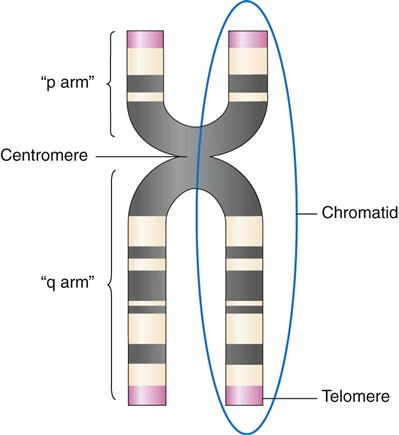
Some things about a person can be known by examining his or her chromosomes. It is important to remember that the information that can be obtained by chromosomal analysis is limited because each chromosome is composed of a large chunk of DNA. Only very large deletions, additions, or rearrangements of DNA show up at the level of the chromosome. Losses or gains of just a few bases (or even tens of thousands) cannot be detected by chromosome analysis.
A karyotype is an organized arrangement of all of the chromosomes present in a cell during the metaphase section of mitosis (Fig. 6-7). A picture of the chromosomes is made. Chromosomes are first paired up and then arranged according to size (largest first) and centromere position. This gross organization of DNA can be used to determine missing or extra whole chromosomes and some large structural rearrangements. A missing gene or a mutated gene would not show up at this level of analysis. What can be learned about the person from whom the karyotype in Fig. 6-7 was made is that the person is human, female, and euploid (has the correct number of chromosome pairs for the species). This person is chromosomally “normal,” although she might have one or more genes that are mutated. If the karyotype is abnormal in any way (had more or less than the normal number or had broken chromosomes), the karyotype would be called aneuploid.
Autosomes are the 22 pairs of human chromosomes (numbered 1 through 22) that do not code for the sexual differentiation of a person. Autosomal chromosomes contain genes that code for all the structures and regulatory proteins needed for normal function. Sex chromosomes are the pair of chromosomes that include the genes for the sexual differentiation of the person. Chromosomally normal males have an X and a Y as the sex chromosomes. Chromosomally normal females have two XXs as the sex chromosomes (see Fig. 6-7).
Gene Structure and Function
A gene is a specific segment(s) of DNA that contains the code (recipe) for a specific protein (see Fig. 6-1). One gene usually codes for one protein; thus genes are the smallest functional unit of the DNA. Each chromosome contains hundreds of genes (and each chromosome is made up of a large segment of DNA). Thus an individual gene is a very small segment of DNA.
For many human traits, one gene controls the expression of that trait in any person. Such traits are known as “single gene traits” (monogenic traits). For each single gene, we have two alleles. An allele (pronounced “ah-lee-el”) is an alternate form (or variation) of a gene. For example, there is one gene for blood type but there are three possible gene alleles (A, B, and O). Each person has only two of the three specific gene alleles for blood type. One of these alleles is on one chromosome 9 of the pair; the other allele is located on the other number 9 chromosome. Because each person only has two number 9 chromosomes, he or she can have only two alleles for blood type. One gene allele was inherited from the person’s mother, and the other gene allele was inherited from the person’s father. Some traits have even more than three possible alleles, but each person has only two. Which blood type gene alleles are inherited from a person’s parents determines which blood type he or she expresses.
If a person has inherited a blood type A allele from his or her mother and a blood type B allele from his or her father, he or she has the A and B alleles; the blood type expressed when the blood bank determines type is type AB. Fig. 6-8 shows this concept. In Fig. 6-8, two people are about to become pregnant. What are the possibilities for this baby to have a specific type of ear shape (pointy, rounded, square, triangular)? The gene for ear shape is trait 1, and it (for the purposes of this explanation) is on chromosome number 6.
Each of the father’s sperm contains only one number 6 chromosome, and each of the mother’s eggs contains only one number 6 chromosome (so that when the sperm fertilizes the egg, the resulting person conceived will have only one pair of chromosome number 6 instead of two pairs of chromosome number 6). In Fig. 6-8, the paternal chromosomes are represented in blue and the maternal chromosomes are represented in pink. Throughout this text, when single gene health problems are described using either a chromosome depiction or a Punnett square depiction, paternal genetic input is represented in blue and maternal genetic input is represented in pink.
Half the father’s sperm have the 1a allele for ear shape, and the other half have allele 1b for ear shape. Half the mother’s eggs have 1c for ear shape, and the other half have 1d. The resulting baby can inherit only a 1a or a 1b from the father, not both; and this same baby can inherit only a 1c or a 1d from the mother—again, not both. The lower portion of Fig. 6-8 shows all the combinations possible for each ear shape gene alleles for any child these two people have.
If a person has two identical alleles for a single gene trait, that person is said to be homozygous for that trait. So if a person has an A blood-type gene allele on one number 9 chromosome and an A blood-type gene allele on the other number 9 chromosome, he or she is homozygous for that trait and will express the A blood type.
If a person has two different alleles for a single gene trait, he or she is heterozygous for that trait. So if a person has an A blood-type gene allele on one number 9 chromosome and a B blood-type gene allele on the other number 9 chromosome, that person is heterozygous for that trait and will express the AB blood type. Because the A and B alleles are equally dominant (co-dominant), they will both be expressed in the actual blood type.
There are differences in expression of the alleles for a trait depending on whether an allele is dominant or is recessive. If a person has an A blood-type gene allele on one number 9 chromosome and an O blood-type gene allele on the other number 9 chromosome, that person is heterozygous for that trait and expresses only the A blood type. Because the A allele is dominant and the O allele is recessive, they will not both be expressed in the actual blood type. Only the dominant allele is expressed, and the recessive allele is “silent.” More information about dominant, recessive, and co-dominant expression is presented later in the “Patterns of Inheritance” section on p. 72.
Phenotype
The phenotype of any gene for a person is what characteristic can actually be observed or, in some cases, determined by a laboratory test. For example, the person who has the AO gene alleles for blood type has the phenotype of type A blood. A person with curly hair has a curly hair phenotype regardless of whether he or she has two alleles for curly hair or one allele for curly hair and one allele for straight hair.
Genotype
The genotype for a person’s single gene trait is what the actual alleles are for that trait—not just what can be observed. A person with a phenotype of type A blood could have either an AA genotype or an AO genotype. The person who has type O blood would have an OO genotype. When a person has homozygous alleles for a trait, we would expect the genotype and phenotype to be the same. When a person has heterozygous alleles for a trait, the phenotype and the genotype are not always the same. Recessive traits are expressed only when the person is homozygous for the alleles. Thus for expressed recessive traits, phenotype and genotype are the same. Dominant traits are expressed whether the person is homozygous for the gene alleles or heterozygous for the gene alleles. Thus for dominant traits, phenotype and genotype can be the same but do not have to be the same.
Gene Expression
The purpose of a gene is to code for the making of a specific protein used by a cell, tissue, or organ within a person. For example, the hormone insulin is a protein. When a person’s blood glucose level starts to rise, the beta cells of the pancreas rapidly make insulin to meet the immediate needs of the person for blood glucose homeostasis.
To continue the cookbook analogy, each gene is the recipe needed to make a specific protein. All the “stuff” that a human body makes—every hormone, every enzyme, every growth factor, every chemical needed to keep the person functioning—is a protein. These proteins are gene products because they are produced when the right gene is “turned on” or expressed. Just a few examples of gene products are insulin, hemoglobin, erythropoietin, angiotensin, and estrogen.
Protein Synthesis
Protein synthesis is the process by which genes are used to make the proteins needed for physiologic function. Remember from your science classes, proteins are made up of individual amino acids hooked together like beads on a string. There are 22 different amino acids. Every protein has a specific number of each of the amino acids and a specific order in which they are placed. If even one amino acid is out of order or completely deleted from the sequence, the protein will be less functional or, perhaps, nonfunctional and unable to perform its job in the body.
For example, the hormone insulin is a protein that contains 51 amino acids in a specific sequence. If some of the amino acids are missing or are in the wrong position, the protein made would be different from real insulin and could not reduce blood glucose levels. Thus the actual order of the amino acids is critical for the final function of any protein.
Within the DNA there is a code for each amino acid (Table 6-2). Each amino acid code is three bases (nucleotides) long. A gene is the recipe for making a specific protein. It contains all the amino acid codes in exactly the right order for that protein. For example, the final active form of the protein insulin has 51 amino acids. Thus the minimum number of bases needed in the gene for insulin would be 153 (3 bases per amino acid × 51 amino acids). Fig. 6-9 shows an example of a short protein made up of only 7 amino acids.
TABLE 6-2
EXAMPLES OF DNA CODES AND RNA CODONS FOR SELECTED AMINO ACIDS
| AMINO ACID | DNA CODE(S) | RNA CODONS |
| Alanine | CGA, CGG, CGT, CGC | GCU, GCC, GCA, GCG |
| Glycine | CCA, CCG, CCT, CCC | GGU, GGC, GGA, GGG |
| Isoleucine | TAA, TAG, TAT | AUU, AUC, AUA |
| Lysine | TTT, TTC | AAA, AAG |
| Tryptophan | ACC | UGG |
| Tyrosine | ATA, ATG | UAU, UAC |
| Start | AUG | |
| Stop | UAA, UAG, UGA |
Stay updated, free articles. Join our Telegram channel

Full access? Get Clinical Tree


